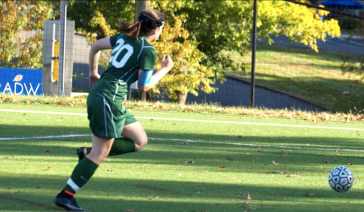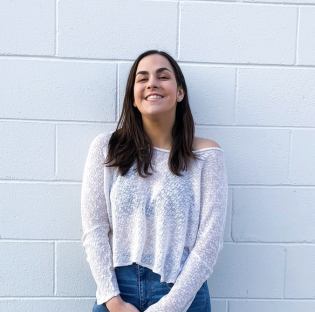
It was the first game of the season as a freshman on the girl’s varsity soccer team for Anat Ferleger at Delaware Valley Friends School in Paoli, Pa.
“I was shocked by the reality of the debilitating effects that it would have on my entire life,” Ferleger, now a freshman at American University studying pre-med bio and public health, said.
The ‘it’ that changed her entire life was a concussion.
According to Heads Up, a concussion is a type of traumatic brain injury caused by a bump, blow or jolt to the head or by a hit to the body that causes the head and brain to move rapidly back and forth.
“I was playing my usual position, right fullback, when I was injured,” Ferleger said. “My coaches allowed me to go back into the game because I was just complaining of ankle pain. Re-entering the game only made my injury worse.”
The American Academy of Orthopaedic Surgeons reported that girls’ soccer players suffered concussions at a significantly higher rate than football players as well as boys in matched sports.
Little did Ferleger know at the time, the injury she was not aware of during the game completely turned her life upside-down.
Symptoms began the next day in school when Ferleger was in class, seeing double vision and experiencing severe headaches. She then left school early to see a physician where she was then diagnosed with a concussion and told to rest for a few weeks and the return to normal activities.
Resting did not only mean sleep but Ferleger was not allowed to read, use her phone or any electronics, or even hang out with friends. Devastated but relieved that her head would feel better, Ferleger obeyed the instructions.
“After symptoms only began to become more severe, I started to see more specialists to figure out what steps to take next,” Ferleger said. “This was just the beginning of what would turn into years of recovery.”
The few weeks Ferleger was told it would take to recover soon turned into months. Ferleger began missing months of school in order to be receiving constant medical care.
She began seeing a tutor to get credit for school and started seeing a vestibular therapist to help her regain stills she lost.
“Vestibular therapy is used to help people regain normal balance and eye movements after a brain injury,” Ferleger said.
Months later, after she began to regain some strength, Ferleger began attending school for one hour, three days a week.
“After two weeks, I was too overwhelmed by the light, sound, electronics and visual clutter that the school environment projected, so I needed to return to homeschooling,” Ferleger said.
Instead of going to math class, English class and lunch, Ferleger’s days were full of doctor appointments, vestibular and vision therapy, little school work and a lot of rest.
One year passed with symptoms worsening.
“After a year of draining symptoms, including double vision, chronic migraines, fatigue, difficulty sleeping, memory loss, light and noise sensitivity and balance problems, we decided to see another neurologist for a second opinion,” Ferleger said. “I was then given the diagnoses of post-concussion syndrome as well as post-traumatic migraines and a few other diagnoses,” Ferleger said.
“Seeing Anat struggle was heartbreaking,” David Ferleger, Anat’s father, said. “Simple tasks caused her pain. She was not herself. Over time, things began to improve, but it took months of seeing her in pain, dozens of appointments, medications and tests in order to get her back on the right track and on her way to recovering from this injury.”
According to US National Library of Medicine National Institutes of Health, only 15 percent of people with a history of TBI still suffer from deficits one year after injury. Ferleger is four years out from her brain injury and this statistic lowers the farther out from the injury the patient is.
After trying lots of medications, newer and stronger medications began to be suggested as an option for Ferleger’s severe headaches and migraine.
“After months of trying multiple medications and supplements, it appeared that none of them seemed to be making a difference and were only causing severe side effects,” Ferleger said.
None of the medications the doctors prescribed seemed to work miracles like she had hoped and therefore, the doctors decided to extend and proceed with more tests to rule out any other causes of these symptoms.
After missing a year of school, Ferleger began to go back for her sophomore year, part-time.
“It was a big milestone in my recovery as it was amazing to be able to see my friends and have some structure back in my life,” Ferleger said. “I was able to tolerate school for about half a day, three times a week.”
The constant severe headaches kept interrupting Ferleger’s day, resulting her trying a nerve block.
“Getting a nerve block meant getting over a dozen shots with an anesthetic near the nerves in my head with the hopes to block the pain,” Ferleger said.
In addition to trying the nerve block, Ferleger was prescribed additional medication to take on a daily basis, but the nerve block only ended up making her symptoms worse.
Throughout the next year, Ferleger continued working with many of her physicians to manage and treat her pain.
“Throughout these two years, I saw dozens of doctors and was working with vision, speech and vestibular therapists multiple times a week. Since the nerve block failed, my doctors had me try botox along with many medications to manage my pain” Ferleger said.
By junior year, Ferleger was back in school full time and learning to manage her lingering symptoms.
Ferleger said, “I was once again a member of society, but on the inside, I was still in constant pain and learning to manage to live with an invisible disability. On the outside, I looked normal but I still had double vision, short-term memory loss and balance problems which were all things mainly only noticeable to me. It took time, but by the end of high school, I learned to live with my new normal. It was not ideal, but it was who I now was.”

Ferleger has made a lot of progress and is now at a point in her life where she is able to reflect on her journey.
“Looking back, I know that my high school experience was not an ordinary one and that the rest of my life will continue to be slightly different because of this experience. Getting a concussion was not how I expected my high school career to start, but I have realized how much I took everything for granted and I now have a new perspective on everything in my life,”Ferleger said. “It made me who I am and even though I will have residual side effects for the rest of my life and still struggle on a daily basis, this is the new me. My concussion is now a part of me and I have accepted that and am learning to thrive and use it as a building block as I begin my journey to become a physician myself.”



